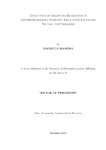Evolution of Grasping Behaviour in Anthropomorphic Robotic Arms with Embodied Neural Controllers
| dc.contributor.supervisor | Cangelosi, Angelo | |
| dc.contributor.author | Massera, Gianluca | |
| dc.contributor.other | School of Engineering, Computing and Mathematics | en_US |
| dc.date.accessioned | 2012-08-30T09:33:13Z | |
| dc.date.available | 2012-08-30T09:33:13Z | |
| dc.date.issued | 2012 | |
| dc.date.issued | 2012 | |
| dc.identifier | 389219 | en_US |
| dc.identifier.uri | http://hdl.handle.net/10026.1/1172 | |
| dc.description.abstract |
The works reported in this thesis focus upon synthesising neural controllers for anthropomorphic robots that are able to manipulate objects through an automatic design process based on artificial evolution. The use of Evolutionary Robotics makes it possible to reduce the characteristics and parameters specified by the designer to a minimum, and the robot’s skills evolve as it interacts with the environment. The primary objective of these experiments is to investigate whether neural controllers that are regulating the state of the motors on the basis of the current and previously experienced sensors (i.e. without relying on an inverse model) can enable the robots to solve such complex tasks. Another objective of these experiments is to investigate whether the Evolutionary Robotics approach can be successfully applied to scenarios that are significantly more complex than those to which it is typically applied (in terms of the complexity of the robot’s morphology, the size of the neural controller, and the complexity of the task). The obtained results indicate that skills such as reaching, grasping, and discriminating among objects can be accomplished without the need to learn precise inverse internal models of the arm/hand structure. This would also support the hypothesis that the human central nervous system (cns) does necessarily have internal models of the limbs (not excluding the fact that it might possess such models for other purposes), but can act by shifting the equilibrium points/cycles of the underlying musculoskeletal system. Consequently, the resulting controllers of such fundamental skills would be less complex. Thus, the learning of more complex behaviours will be easier to design because the underlying controller of the arm/hand structure is less complex. Moreover, the obtained results also show how evolved robots exploit sensory-motor coordination in order to accomplish their tasks. | en_US |
| dc.language.iso | en | en_US |
| dc.publisher | University of Plymouth | en_US |
| dc.subject | Genetic Algorithm | |
| dc.subject | Humanoid Robot | |
| dc.subject | Reaching | |
| dc.subject | Grasping | |
| dc.subject | Neural Network | |
| dc.subject | Adaptive Behaviour | |
| dc.subject | Evolutionary Robotics | en_US |
| dc.title | Evolution of Grasping Behaviour in Anthropomorphic Robotic Arms with Embodied Neural Controllers | en_US |
| dc.type | Thesis | en_US |
| plymouth.version | Full version | en_US |
| dc.identifier.doi | http://dx.doi.org/10.24382/1393 |
Files in this item
This item appears in the following Collection(s)
-
01 Research Theses Main Collection
Research Theses Main


